Death is the only guarantee in Neon Chrome. With ever-changing levels and countless ways to meet your demise, death is the only way to learn and grow stronger as the game’s heroic hacker. This cyberpunk rougelike by Indie developer 10tons screams 80s sci-fi at the top of its lungs with its Tron-like atmosphere and electric piano riffs that help make up the soundtrack. You will need to quickly adapt to your environment and make difficult choices on the fly as enemies close in to halt your climb to the top of the arcology (huge sci-fi tower) known as Neon Chrome.
Neon Chrome takes place in a dystopian future, where millions of people inhabit the titular Neon Chrome. This mega-structure is run by the game’s antagonist — The Overseer, who neurally controls all facets of the massive building through a chair seated at the top of Neon Chrome. The player controls an unnamed hacker who has decided to attempt to end The Overseer’s reign of violence and tyranny through the use of countless clones known as Assets. These clones act as your tools of destruction as you wage war on Neon Chrome.
Story & Gameplay: A Good Balance
The narrative elements of Neon Chrome are brilliantly done, as the game recognizes that the story is not the star of the show for this dungeon-crawling shooter. This allows the gameplay to take center stage, while the story acts as a backdrop to provide a means of motivation for you to climb Neon Chrome and face off with The Overseer. This mystery behind the story led me to never be entirely sure whether the actions of my character were just. Am I unknowingly a pawn in The Overseer’s grand scheme? How are the hundreds of “Assets” that I lead to death being provided to me? These questions in and of themselves help bolster the scarce narrative.
Neon Chrome relies on the narration of The Overseer and Neon Chrome’s A.I. computer system to explain the backstory for the game. Instead of dialogue-heavy cutscenes breaking up the momentum of gameplay, Neon Chrome adds these narrative sections mid-level. This seamless transition between letting loose hundreds of rounds of ammunition and learning more about the history of Neon Chrome allows the player to never feel like the action has stopped.
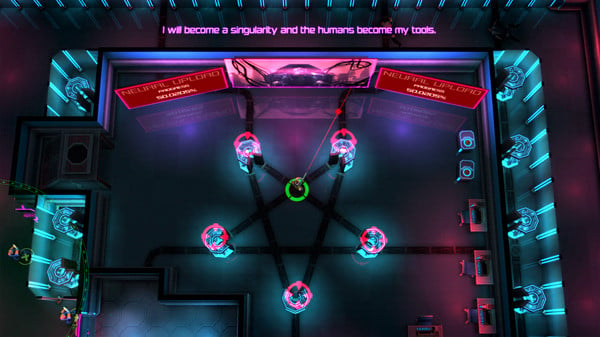
The heart of Neon Chrome‘s gameplay lies in its ability to create a new experience with every playthrough. This begins with the Asset selection before each run. The game will provide three options for an Asset to choose from, each with a different role. Roles carry unique abilities and vary from the sneaky, critical-heavy Assassin to the personal drone-wielding Hacker.
Procedurally-generated levels assure that each attempt at climbing Neon Chrome is different from the last. Each floor has a new set of enemies and traps laid out on an entirely new design, so every level requires a new strategy to reach the elevator that leads to the next floor. This requires players to quickly adapt to their environment in order to effectively use cover and not find themselves trapped. Scrambling into dead-end rooms out of panic was an all-too common way I met my demise, but that just speaks to the frantic action Neon Chrome produces. Whether it’s blasting through walls to create safer routes or sticking to the shadows to pull off sneak attacks, every run made in Neon Chrome entails a unique path to your objective.
While I love the random Asset selection of Neon Chrome, I couldn’t help but feel disconnected with my protagonist. Simply called “The Unknown Hacker”, I felt like the main character was just a pile of pixels. I walked to a chair every time my Asset met its maker. Hell, I couldn’t even 100 percent confirm its gender — I decided on female, but I’m seriously still unsure. Though the lack of heavy narrative lends itself to an excellent gameplay experience, I would have appreciated some “character” in my main character.
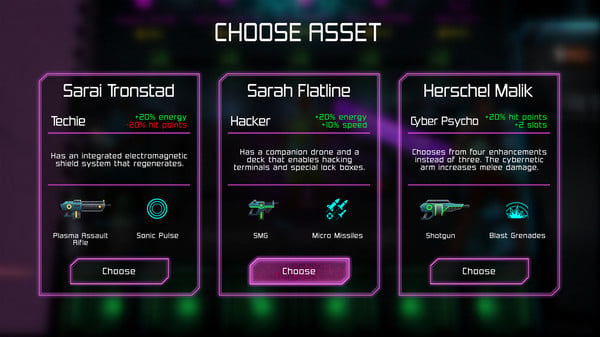
Neon Chrome is unapologetic in its difficultly.
There is no difficulty setting and the game pulls zero punches. It will metaphorically punch you in the face repeatedly if you don’t learn from your mistakes. Especially when you reach one of its lethal bosses. These guys have enough firepower to rival Rambo on a bad day. As crazy as it sounds, that’s part of the game’s charm — much like the Dark Souls series. Learning your enemies’ attack patterns and formulating a new strategy on how to deal with them is a core mechanic for Neon Chrome.
Ion bullets, explosive barrels, and deadly traps are just a few of the dangers players can expect to both love and hate at once during their time with Neon Chrome. Like many roguelike games, death is the only way to learn how to best your enemies. With each death comes knowledge on how to hurdle the game’s many obstacles.
By using currency called “credits” that you collect in each playthrough, you can equip your next Asset with new abilities and boost their stats to increase your probability of survival during your next outing in the Neon Chrome. It was a strange feeling of both frustration and excitement as I died, since I could then use my hard-earned credits to strengthen my Assets and equip them with stat boosts to attributes like health, damage, and luck.
In addition to credits, players can expect to collect a ton of weapons and cybernetic abilities while climbing Neon Chrome. There are a multitude of different weapons types, ranging from shotguns to Electron railguns. Additionally, weapons can have varying ammunition properties like Ion, which delivers more damage to robots. Cybernetic abilities enhance your Assets by giving them perks that increase their lethality and durability. For example, Duramac Bone Lacing gives players a 15 percent health boost and a 50 percent increase in melee damage.
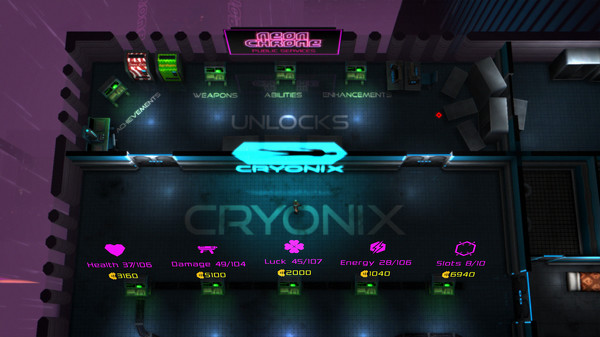
The assurance that you will eventually bite the dust inspires experimentation with each new playthrough. Since you have no control over which Assets will be offered to you, I often found myself learning new roles which only added to the unpredictability of the game. Each level holds countless possibilities to change the make-up of your Asset. Floors have the chance to have weapon-enhancing Armocore crates, pods containing new weapons and enhancements to collect, and chambers where your Asset can equip one of three cybernetic enhancements. The randomly generated perks and Assets promote experimentation by forcing players to utilize strategies they were previously unfamiliar with.
Difficult choices are a cornerstone for Neon Chrome, making every decision the difference between success and failure. Prior to each run, you will have multiple options on how to spend your credits. Players are forced to choose whether to buy stat boosts to attributes like health and damage for long-term benefits or to purchase powerful weapons and enhancements for short-term benefits that only apply to the next run, in hope it will be a successful one.
Once inside Neon Chrome, attacks need to be planned, or you’ll find yourself selecting a new Asset sooner than you thought. Health is very hard to come by, as its availability often relies solely on luck. Each shot your Asset endures makes your ability to reach the next checkpoint seem that much more difficult. Finding ways to pull as few enemies as possible into combat and actively utilizing your environment is critical to survival. The danger attached to each decision makes Neon Chrome an exhilarating experience.
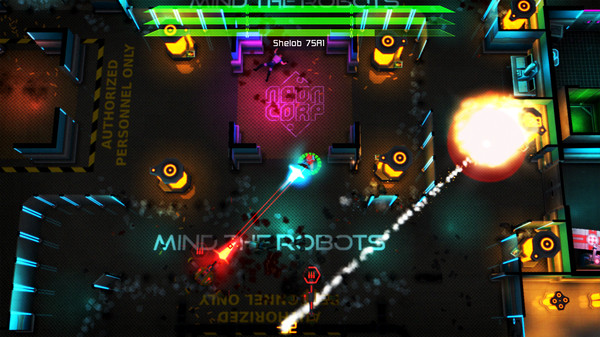
Neon Chrome announces its 80s science fiction setting from the moment you boot up the game.
The first thing that hits you is the high-octane soundtrack filled with the electronically synthesized beats from America’s cheesiest era. It made me want to grow out a mullet, slip into my most obnoxiously colored spandex, and pop in an aerobic workout tape into the VHS.
The atmosphere surrounding Neon Chrome reminded me of the old sci-fi movies that severely overestimated the technological advances that were to come. Most notably, the famous 1982 movie Tron. As my character strapped herself into the Immersion Chair to enter the dangerous and foreign world within the Neon Chrome, I couldn’t help but notice the strong similarities between the game and Tron. The Overseer heckles you with his best bad-guy voice as you battle your way to his chamber, deep within the citadel. The whole experience felt like I was playing a love letter to 80s science fiction, and I loved it.
Despite being randomly generated, the level designs themselves are far from bland. They often have tons of rooms to explore that are filled with traps and wide ranging aesthetic make-up, so storming each room has a different feel to it. This calls for players to read the room to identify where to hide for cover and which halls to draw enemy fire from.

With such an excellent atmosphere, I wished the enemies were just as inspired. Enemy designs range from soldier guy to robot thing. There were few enemies (aside from the climactic bosses) that offered any sort of spectacle in their design. Which is a shame, since the enemy attacks and A.I. themselves are so well done.
Neon Chrome is an excellent addition to the bullet-hell twin-stick shooter genre that oozes with originality and ensures that no level is exactly the same as another. Despite a lackluster protagonist and simple enemy designs, Neon Chrome delivers on an excellent gameplay experience packaged in 80s science fiction that will keep players sending hundreds of Assets to their graves like pigs to the slaughter for many, many hours.


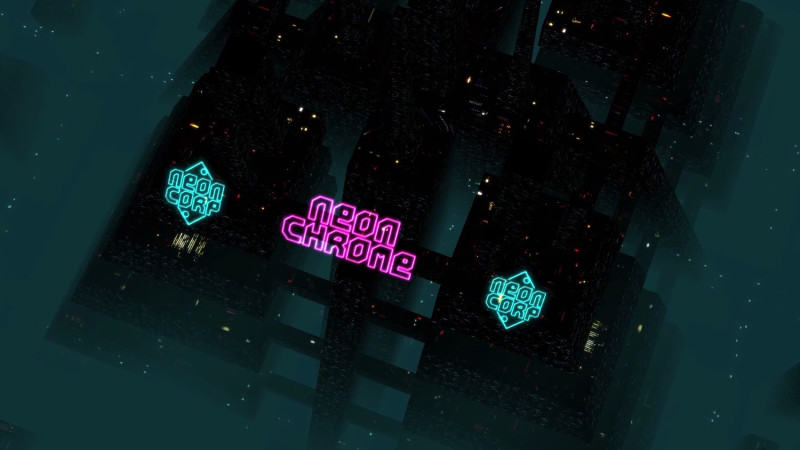





Published: Jun 14, 2016 01:49 pm